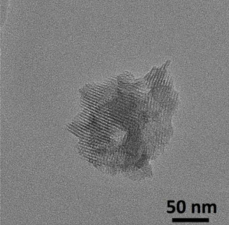Media
Team led by HKU Faculty of Dentistry fights oral bacteria with nanotechnology
10 Feb 2015
A team led by researchers from the Faculty of Dentistry of the University of Hong Kong (HKU) has applied nanotechnology to improve the effectiveness of a commonly used antiseptic against the growth of harmful bacteria found in the mouth.
In their pioneering study, published in the science journal PLoS ONE, the researchers created a slow-release and long-lasting source of antiseptic by pre-soaking porous nanoparticles of silica in a solution of chlorhexidine in its pure chemical form. Chlorhexidine is the active ingredient in disinfectants widely used in medicine and dentistry.
In laboratory tests judged by the naked eye, the nanoparticles containing the pure chlorhexidine curbed the growth of several types of bacteria that are linked to dental infection, cavities, and gum disease. This antibacterial effect lasted for 3 days. By contrast, the antibacterial effect of mouth rinse containing a low concentration of chlorhexidine as a chemical compound lasts only 6 to 10 hours, the researchers note.
Furthermore, the chlorhexidine-loaded nanoparticles not only killed free-floating, or planktonic, bacteria but also prevented bacteria from growing over a plastic surface to form an attached colony called a biofilm. Because bacteria can cause diseases in humans by forming biofilms, the authors conclude that their new nanoparticle product “may be developed as a novel and promising anti-biofilm agent for clinical use”.
The key to the product’s effectiveness is the way in which the silica nanoparticles quickly absorb but slowly release the chlorhexidine. This property relies on the small diameter of the nanoparticles, on average about 140 nm (1 nanometre, or nm, is a millionth of a millimetre), as well as the presence of many narrow, hollow channels called mesopores, each with a width of about 2.5 nm. After overnight immersion in a solution of pure chlorhexidine dissolved in an alcohol (ethanol), the porous nanoparticles took up more than a fifth (21.8%) of their own weight in chlorhexidine.

Three oral bacteria together formed a mixed biofilm (top photo), but not after treatment with chlorhexidine-loaded nanoparticles (bottom photo), as shown under confocal laser scanning microscopy, where living cells are stained green*
Relatively low concentrations of the chlorhexidine-loaded nanoparticles were able to stop the visible growth of bacteria in 1 day, when added to each of five liquid samples of harmful oral bacteria in free-floating form (minimum inhibitory concentration of 50 - 100 μg/mL against Streptococcus mutans, Streptococcus sobrinus, Fusobacterium nucleatum, Aggregatibacter actinomycetemcomitans, and Enterococcus faecalis). In addition, low concentrations (100 - 200 μg/mL) inhibited visible growth in 1 day when added to the five different bacteria as preformed single-species biofilms living on a plastic surface. By contrast, empty nanoparticles had no antibacterial effect.
In a further experiment, the researchers added chlorhexidine-loaded nanoparticles to three different combinations of bacteria—all including Porphyromonas gingivalis, an important bacterial species underlying gum disease—and then allowed them to grow on a plastic surface to form so-called mixed biofilms. Low concentrations of the nanoparticles (12.5 - 100 μg/mL) prevented the development of mixed biofilms for up to 3 days. For example, 100 μg/mL stopped the spread of bacteria for 3 days when added to a culture containing Streptococcus sobrinus, Fusobacterium nucleatum, and Porphyromonas gingivalis, both when judged by the naked eye and when viewed by microscopy (scanning electron microscopy and confocal laser scanning microscopy).
The team concludes that their “proof of concept” study shows that their new product has “potent antibacterial effects”. Noting that the type of silica in the nanoparticles is approved in the US for use in implants, the team comments that depending on more studies, the chlorhexidine-loaded nanoparticles could be developed for use against oral biofilms in humans.
Researchers who took part in this study, funded by the Hong Kong Research Grants Council, were Prof Lijian Jin (Clinical Professor in Periodontology and project leader) and Ms Xuan Li (PhD student), HKU Faculty of Dentistry; Dr C Jayampath Seneviratne at the Faculty of Dentistry, National University of Singapore; Dr Ken CF Leung and Mr Chi-hin Wong (PhD student) at the Department of Chemistry, The Hong Kong Baptist University; Mr Siu-fung Lee (PhD student) at the Department of Chemistry, The Chinese University of Hong Kong; and Prof Ping-chung Leung, Dr Clara BS Lau (Assistant Director), and Dr Elaine Wat (Postdoctoral Fellow) at the Institute of Chinese Medicine and Partner State Key Laboratory of Phytochemistry & Plant Resources in West China, The Chinese University of Hong Kong.
*Photos used under a Creative Commons Attribution 2.5 Generic License. Source: Seneviratne CJ, Leung KC-F, Wong C-H, Lee S-F, Li X, Leung PC, Lau CBS, Wat E, Jin L. Nanoparticle-encapsulated chlorhexidine against oral bacterial biofilms. PLoS ONE 9(8): e103234. doi:10.1371/journal.pone.0103234. Open access article: http://bit.ly/10gZy5i, Medline link: http://www.ncbi.nlm.nih.gov/pubmed/25170958.
Media contact: Ms Sau-wan Cheng, Knowledge Exchange Officer, HKU Faculty of Dentistry; Tel: 2859 0410; E-mail: [email protected]

